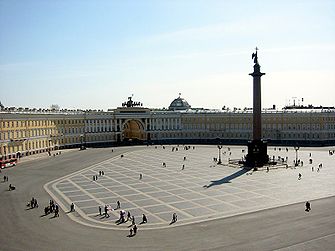- Palace Square
-
Palace Square (Russian: Дворцовая площадь, Dvortsovaya Ploshchad), connecting Nevsky Prospekt with Palace Bridge leading to Vasilievsky Island, is the central city square of St Petersburg and of the former Russian Empire. It was the setting of many events of worldwide significance, including the Bloody Sunday (1905) and the October Revolution of 1917.
 View of the square with the Alexander Column from an open window of the Hermitage Museum in the Winter Palace.
View of the square with the Alexander Column from an open window of the Hermitage Museum in the Winter Palace.
The earliest and most celebrated building on the square is the baroque white-and-azure Winter Palace of Russian tsars (1754–62), which gave the square its name. Although the adjacent buildings are designed in the Neoclassical style, they perfectly match the palace in their scale, rhythm, and monumentality. The opposite, southern side of the square was designed in the shape of an arc by George von Velten in the late 18th century. These plans were executed half a century later, when Alexander I of Russia envisaged the square as a vast monument to the Russian victory over Napoleon and commissioned Carlo Rossi to design the bow-shaped Empire-style Building of the General Staff (1819–29), which centers on a double triumphal arch crowned with a Roman quadriga.
The centre of the square is marked with the Alexander Column (1830–34), designed by Auguste de Montferrand. This red granite column (the tallest of its kind in the world) is 47.5 metres high and weighs some 500 tons. It is set so well that no attachment to the base is needed.
The eastern side of the square is occupied by Alessandro Brullo's building of the Guards Corps Headquarters (1837–43). The western side, however, opens towards Admiralty Square, thus making the Palace Square a vital part of the grand suite of St Petersburg squares.
The square also serves as open-air venue for concerts by international acts, including Andrea Bocelli, Roger Waters, The Rolling Stones, AC/DC, Duran Duran, Anastacia, Elton John, Paul McCartney, Shakira, Madonna, Sting.
References
- V.I. Pilyavsky. Palace Square in Leningrad. Moscow, 1958.
Pedestrian zones of Saint Petersburg by creation year Pedestrian
zones1996Malaya Konushennaya Street19981999Planernaya Street (Avenue to Liquidators Chernobyl Accidents)20002001Gospitalniy pereulok • 6-7 Liniya of Vasilievsky Island • Finskiy pereulok • Bulvar Novatorov • On ninth of January Prospekt • Tankistov Street • Volodarskogo Street • Quarter 5 (Rzhevka) • Quarter 11 • Svoboda Square • Rubakina Street • Alexandrovskaya Street • near Zvyozdnaya • near Lomonosovskaya, Matushenko Street • Nizhnaya Doroga • near Staraya Derevnya • Akademitheskiy Prodpekt • Arts Square2002near Shuvalovo • Quarter 18 - 18А • Burenin Street • Blagodatnaya Street (first stage) • Kommunarov Street • near Gorkovskaya, Alexander Park • Sadovaya Street, Tsarskoye Selo • Turku Street • Quarter 24 • Konushenniy Pereulok • Kuznechniy Pereulok • Palace Square2003Andreevskie Dvoriki: 27, 6 Liniya of Vasilievsky Island · 32, 7 Liniya of Vasilievsky Island • near Udelnaya • Rizhskaya Street • Quarter 5 (South-West) • Blagodatnaya Street (second stage) • Shlisselburgskiy Prospekt • near Petrogradskaya, Bezimyanniy Pereulok • Klenovaya Alleya • Millionnaya Street • Griboyedov Canal Quay • Bolshaya Konushennaya Street • Solyanoy Pereulok2009Blagoeva streetMemorials Alexander Column • Bronze Horseman • Hero-City Obelisk • Column of Glory • Cruiser Aurora • Peter I near St. Michael's Castle • Church of the Savior on Blood • Alexander Pushkin in Arts Square • Nikolai Gogol in Konushennaya Street • Chesme Column • Kagul Obelisk • Monument to Nicholas I • Mother Motherland • Moscow Triumphal Gate • Narva Triumphal Gate • Vasily Korchmin • Liquidators Chernobyl Accidens • Genio loci • Barometer clock • Saint Petersburgs policeman • Sphere fountain • Photographer • ReproductCoordinates: 59°56′21″N 30°18′57″E / 59.93917°N 30.31583°E
Categories:- Pedestrian zones of Saint Petersburg
- Palace Square
- Carlo Rossi buildings and structures
Wikimedia Foundation. 2010.
